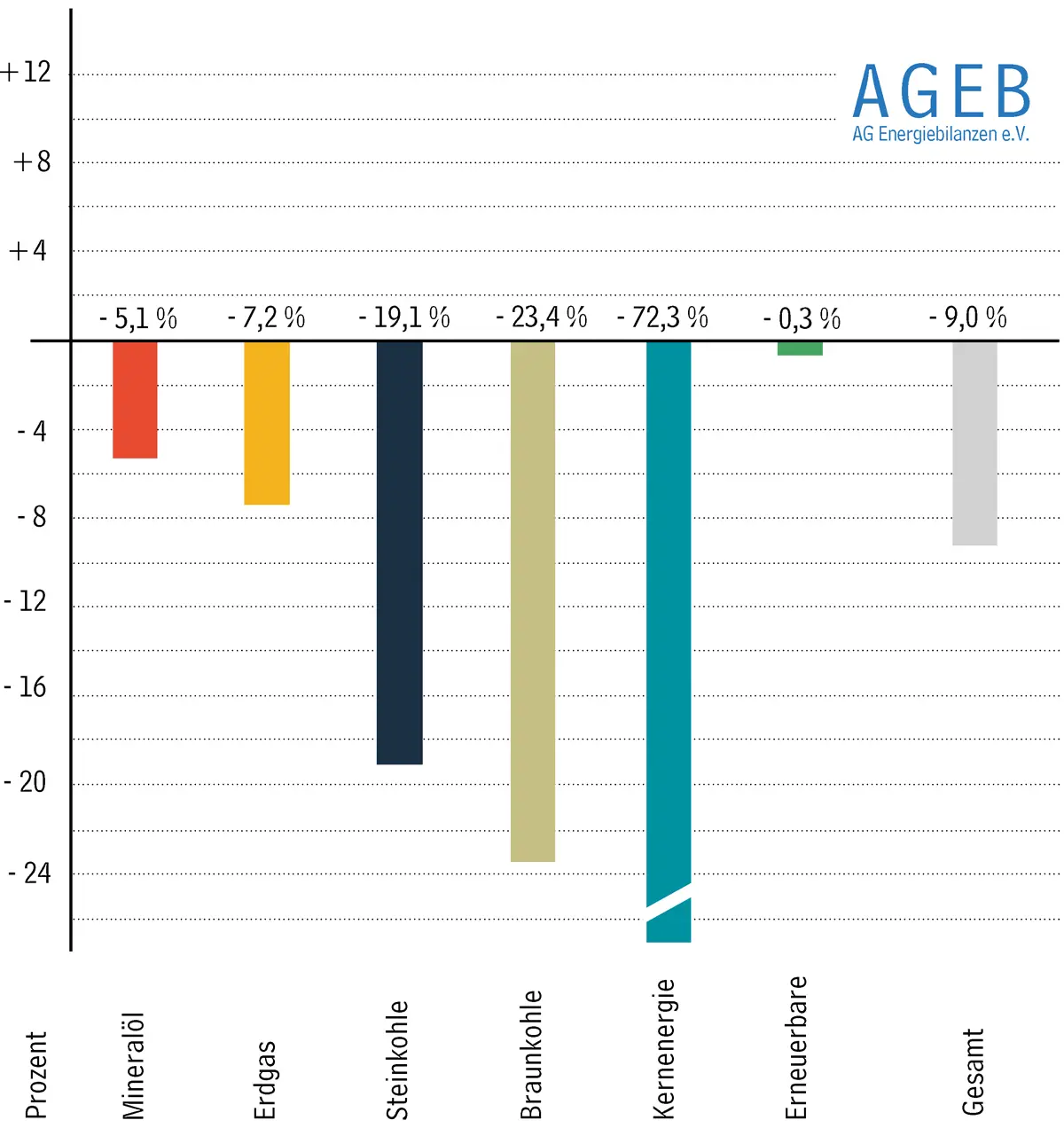| Source | Change compared to previous year |
|---|---|
| Oil | -5,1 |
| Gas | -7,2 |
| Hard Coal | -19,1 |
| Lignite | -23,4 |
| Renewables | -0,3 |
| Nuclear | -72,3 |
| Total | -9,0 |
Translation from German:
Energy consumption in Germany in 2023 will be shaped in particular by economic development. This year’s economic output could fall by around 0.5 percent. Energy-intensive industries in particular are experiencing a decline in production, which is having a noticeable impact on energy consumption.
So far, the warmer weather compared to the previous year has had a consumption-reducing effect on the demand for space heating. According to calculations by AG Energiebilanzen, around one fifth of the total percentage reduction in consumption is likely to have been due to the weather.
A third consumption-reducing effect results from the energy price level. Although import prices for the most important imported energies have fallen significantly over the course of the year, prices are still well above the 2021 level. The Working Group on Energy Balances assumes that the persistently high prices will both encourage savings and substitutions, but also lead to a reduction in energy-intensive production in Germany.
Demographic developments will have the effect of increasing consumption. A migration-related influx of 1.35 million people led to an increase in energy consumption of around 200 PJ.
Developments in the first three quarters
According to preliminary calculations by AG Energiebilanzen, energy consumption in Germany in the first nine months of the current year was 9% lower than in the same period of the previous year. Overall, the demand for energy reached a level of 7,813 PJ or 266.6 million tons by the end of September 2023. TCE. Excluding the impact of the weather, primary energy consumption would have fallen by 5.8% in the first nine months of the year.
Consumption of mineral oil fell by 5.1% year-on-year to 2,860 PJ (97.6 million TCE) in the first three quarters of 2023. While the consumption of petrol increased by more than 3%, the consumption of diesel fuel fell by a good 3%. The consumption of aviation fuel rose by 5 percent. Sales of light heating oil fell slightly by 3 percent. Deliveries of crude gasoline to the chemical industry were 16 percent lower.
Natural gas consumption fell by 7.2% to 1,838 PJ (62.7 million TCE) in the first three quarters of 2023. This development reflects declines in industrial demand as well as savings in private households and in the trade, commerce and services sector. Electricity generation from natural gas fell by 4%. The generation of district heating based on natural gas fell by just under 3%.
Hard coal consumption fell by 19.1% to 678 PJ (23.1 million TCE) in the reporting period. The 35% decline in electricity generation from hard coal had a particular impact on this development. Crude steel production fell by 3.6% as a result of the economic slowdown and coking plants reduced their output by 12%. Demand for hard coal in the steel industry fell by 1.6% overall.
At 663 PJ (22.6 million TCE), primary energy consumption of lignite in the first three quarters of 2023 was 23.4% lower than in the same period of the previous year. The decline essentially corresponds to the reduced deliveries to power plants for general supply. Electricity generation from lignite was influenced by the decline in electricity consumption, the reduction in generation capacities in the course of the gradual coal phase-out, the increase in electricity production from wind turbines and increased electricity imports from neighboring countries.
Electricity generation from nuclear energy fell by 72% in the first three quarters of 2023 compared to the same period of the previous year. The sharp decline is due to the shutdown of the last three nuclear power plants and their final decommissioning on April 15, 2023. Since this date, nuclear energy has no longer contributed to the energy supply in Germany.
In the first nine months of the year, 9.7 billion kilowatt hours (billion kWh) more electricity was imported from abroad than exported. Until May of the current year, the electricity exchange balance showed a clear export surplus, since then more has been imported on balance. AG Energiebilanzen sees this development as an indication of a well-functioning European electricity market: in some cases, cheaper generation options were available abroad than in Germany during the reporting period.
The contribution of renewable energies fell slightly by 0.3% to 1,516 PJ (51.7 million TCE) in the first nine months. Electricity generation from wind increased by 3 percent. There was a slight decrease of 1 percent in solar energy. Electricity generation from hydropower increased by 14 percent. Biomass, which accounts for almost 55% of the total primary energy consumption of renewable energies, fell 3% short of the previous year’s figure.
According to estimates by AG Energiebilanzen, energy-related CO₂ emissions fell by around 11% in the first three quarters of 2023 as a result of lower overall consumption, particularly of fossil fuels. This corresponds to a reduction in the order of 55 million tons (mt). For 2023 as a whole, AG Energiebilanzen expects energy-related CO₂ emissions to decrease by 10.7%. The reduction contribution could reach around 65 million tons. Development of primary energy consumption from January to September 2023 Changes in percent - total 7,813 PJ or 266.6 million tce
Berlin - In the first nine months of 2023, primary energy consumption fell by 9% to 7,813 petajoules (PJ) or 266.6 million tons of coal equivalent (mtce) compared to the same period of the previous year. The decline is primarily due to the weak economic development, high energy prices and warmer weather compared to the previous year.
Source: Working Group on Energy Balances Further shifts in the energy mix Structure of primary energy consumption in Germany 1st-3rd quarter 2023 - total 7,813 PJ or 266.6 million TCE Shares in percent (previous year’s period in brackets)
Primary energy really bothers me as a metric: wind and solar are counted as the amount of heat which would be produced if you took the electricity they generated and ran it through a resistive heater. By contrast, fossil and nuclear energy get counted as the amount of heat which is used to drive their generators. Transport fuels, the same thing, but an even larger fraction is wasted. Since they waste large fractions of that heat, “primary energy” from those sources is a much larger amount of energy than the amount of useful energy that’s available. This causes any kind of transition to renewables or high-efficiency electric vehicles and heat pumps to look like a drop in primary energy consumption, even if it doesn’t change the amount of useful work people managed to achieve.
So you propose a sort of metric of “energy utility”?
Something like that, yeah. It would do a much better job of measuring the energy transition than primary energy does
You are thinking of final energy consumption.
Something close to that, yeah.
Fuck, thats a lot. Next time hopefully without the economic downturn.
I’m no economist, but it wouldn’t surprise if there’s more of economic instability to come; especially as part of economic restructurings in the context of decarbonisation of industrial, construction and communal processes. Several industries will completely vanish or be unrecognisable, others will boom and and then bust once the priorities shift. That seems like a lot of ‘economic noise’ or whatever that’s called.
I suppose that’s pretty much guaranteed. I am worried that the supply chains stop working before we get serious about climate repair. It’ll be interesting to see what happens to the fossil fuel companies when the “proven resources” in the ground become worthless because there are barely any buyers anymore and borrowing against it is no longer possible. I don’t know how much they do that - but it would have implications for the finance people.



